instrument cluster VOLKSWAGEN ID.4 2020 Owner´s Manual
[x] Cancel search | Manufacturer: VOLKSWAGEN, Model Year: 2020, Model line: ID.4, Model: VOLKSWAGEN ID.4 2020Pages: 417, PDF Size: 6.31 MB
Page 21 of 417
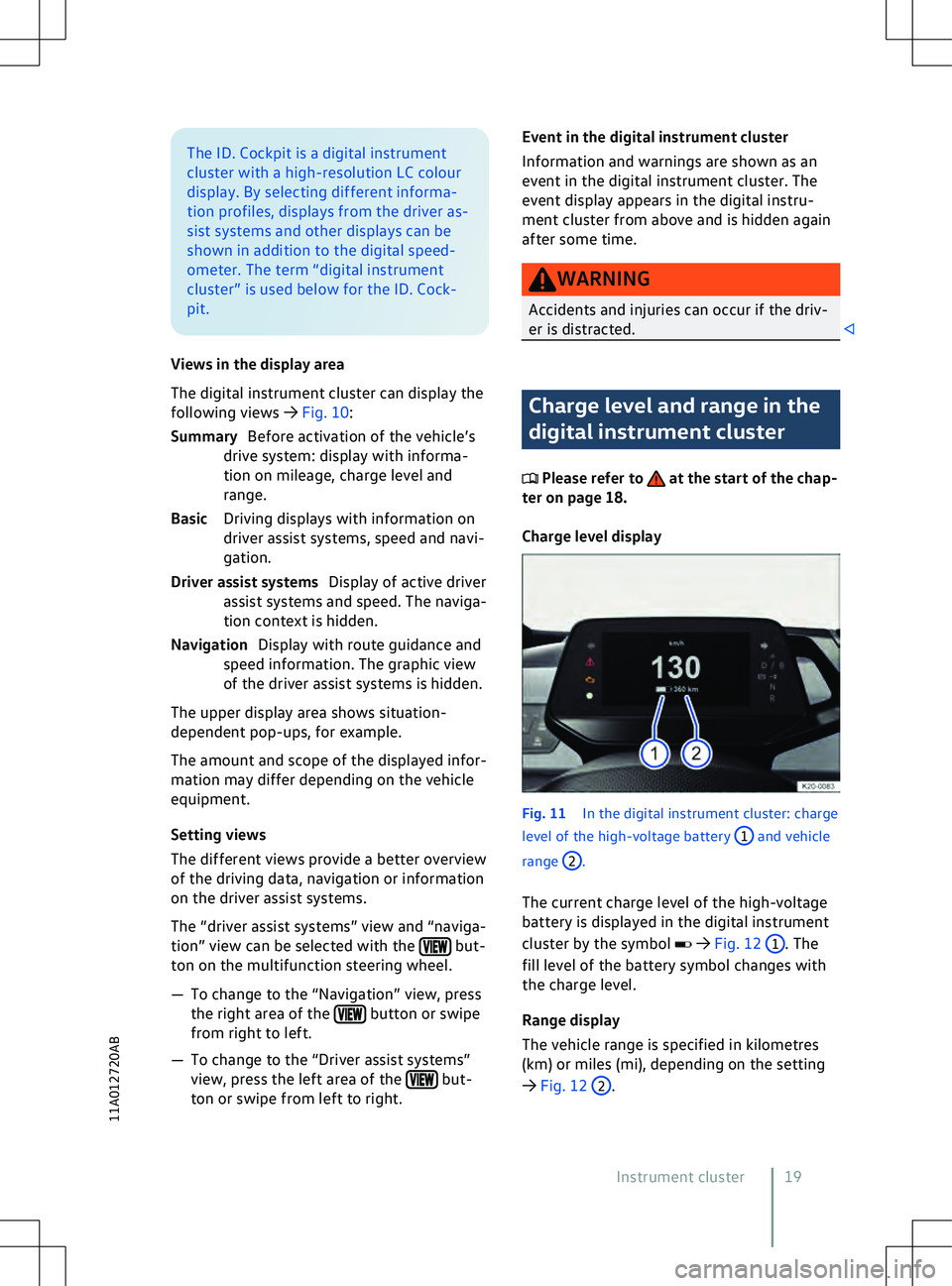
The ID. Cockpit is a digital instrument
cluster with a high-resolution LC colour
display. By selecting diff
erent informa-
tion profiles, displays from the driver as-
sist systems and other displays can be
shown in addition to the digital speed-
ometer. The term “digital instrument
cluster” is used below for the ID. Cock-
pit.
Views in the display area
The digital instrument cluster can display the
following views
Page 22 of 417
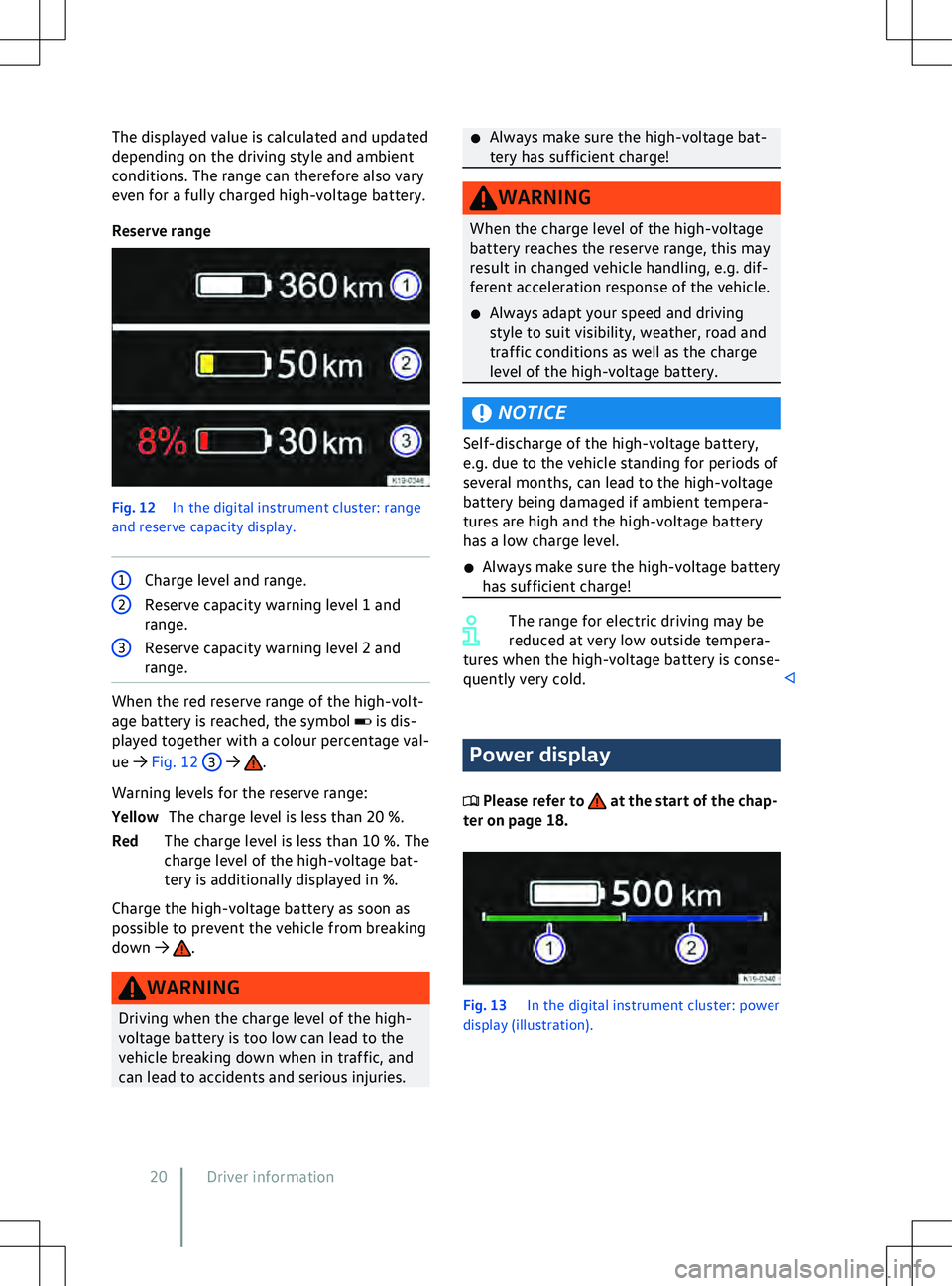
The displayed value is calculated and updated
depending on the driving style and ambient
conditions. The range can theref
ore also vary
even for a fully charged high-voltage battery.
Reserve range Fig. 12
In the digital instrument cluster: range
and reserv
e capacity display.1
Charge level and range. 2
Reserve capacity warning level 1 and
range. 3
Reserve capacity warning level 2 and
range. When the red reserve range of the high-volt-
age battery is reached, the symbol
is dis-
played together with a colour percentage v
al-
ue
Page 26 of 417
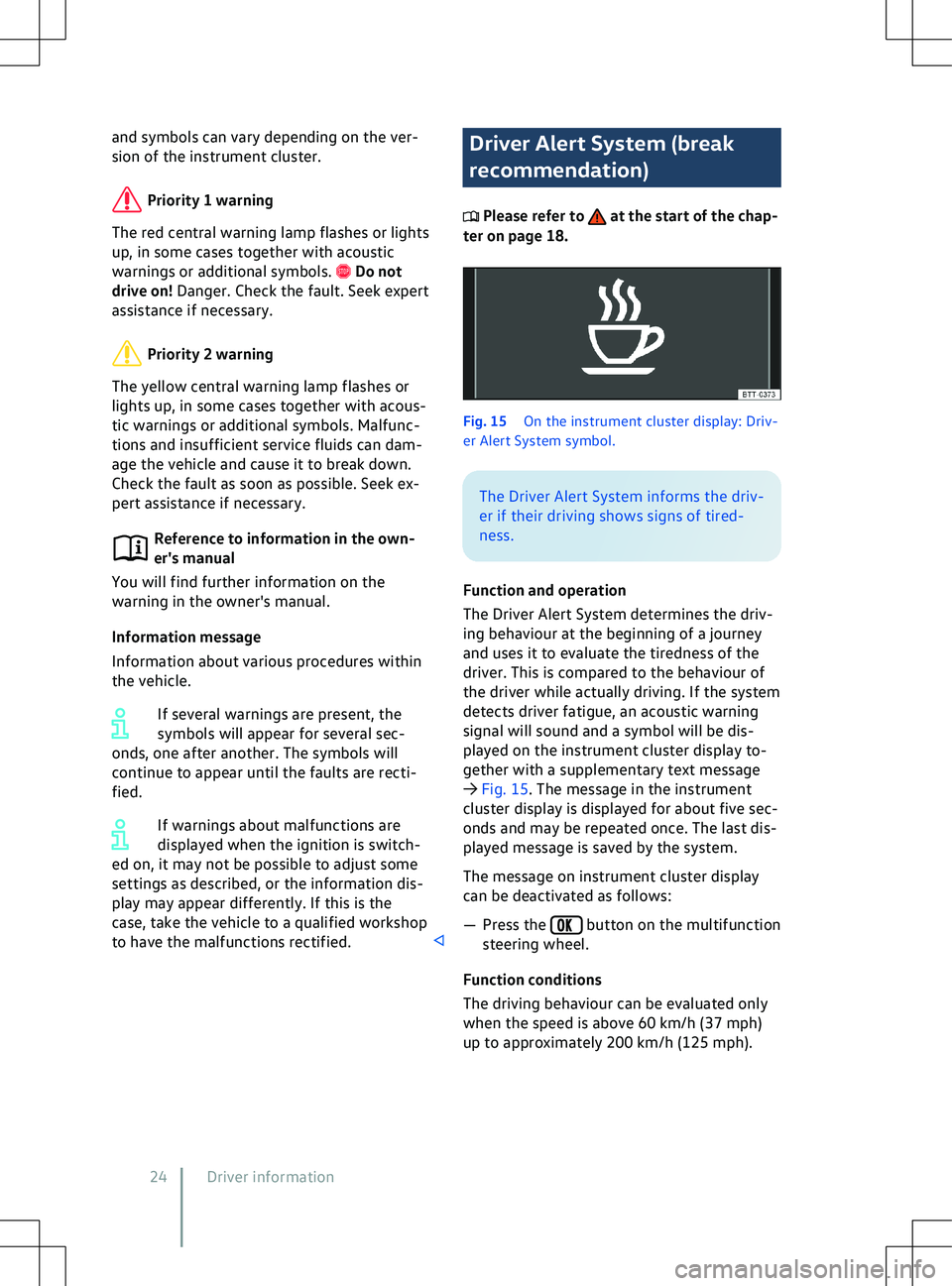
and symbols can vary depending on the ver-
sion of the instrument cluster.
Priority 1 warning
The red central warning lamp flashes or lights
up, in some cases together with acoustic
warnings or additional symbols. Do not
driv
e on! Danger. Check the fault. Seek expert
assistance if necessary. Priority 2 warning
The yellow central warning lamp flashes or
lights up, in some cases together with acous-
tic warnings or additional symbols. Malfunc-
tions and insufficient service fluids can dam-
age the v
ehicle and cause it to break down.
Check the fault as soon as possible. Seek ex-
pert assistance if necessary. Reference to information in the own-
er
Page 28 of 417
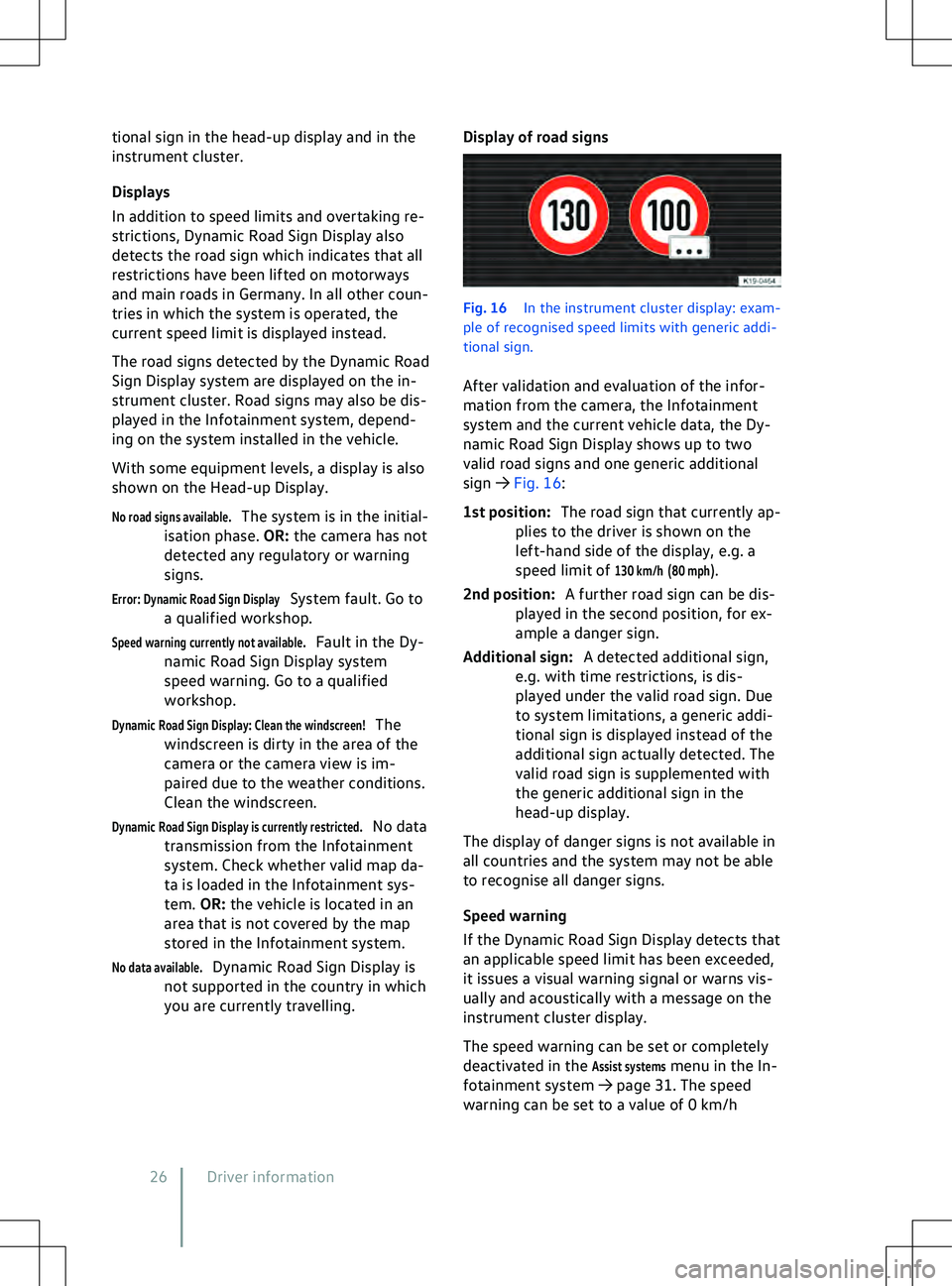
tional sign in the head-up display and in the
instrument cluster.
Displays
In addition to speed limits and o
vertaking re-
strictions, Dynamic Road Sign Display also
detects the road sign which indicates that all
restrictions have been lifted on motorways
and main roads in Germany. In all other coun-
tries in which the system is operated, the
current speed limit is displayed instead.
The road signs detected by the Dynamic Road
Sign Display system are displayed on the in-
strument cluster. Road signs may also be dis-
played in the Infotainment system, depend-
ing on the system installed in the vehicle.
With some equipment levels, a display is also
shown on the Head-up Display.
The system is in the initial-
isation phase. OR: the camera has not
detected any regulatory or warning
signs.
System fault. Go to
a qualified workshop.
Fault in the Dy-
namic Road Sign Display system
speed warning. Go to a qualified
workshop.
The
windscreen is dirty in the area of the
camera or the camera view is im-
paired due to the weather conditions.
Clean the windscreen.
No data
transmission from the Infotainment
system. Check whether valid map da-
ta is loaded in the Infotainment sys-
tem. OR: the vehicle is located in an
area that is not covered by the map
stored in the Infotainment system.
Dynamic Road Sign Display is
not supported in the country in which
you are currently travelling.
No road signs available.
Error: Dynamic Road Sign Display
Speed warning currently not available.
Dynamic Road Sign Display: Clean the windscreen!
Dynamic Road Sign Display is currently restricted.
No data available.
Display of road signs Fig. 16
In the instrument cluster display: e
xam-
ple of recognised speed limits with generic addi-
tional sign.
After validation and evaluation of the infor-
mation from the camera, the Infotainment
system and the current vehicle data, the Dy-
namic Road Sign Display shows up to two
valid road signs and one generic additional
sign
Page 30 of 417
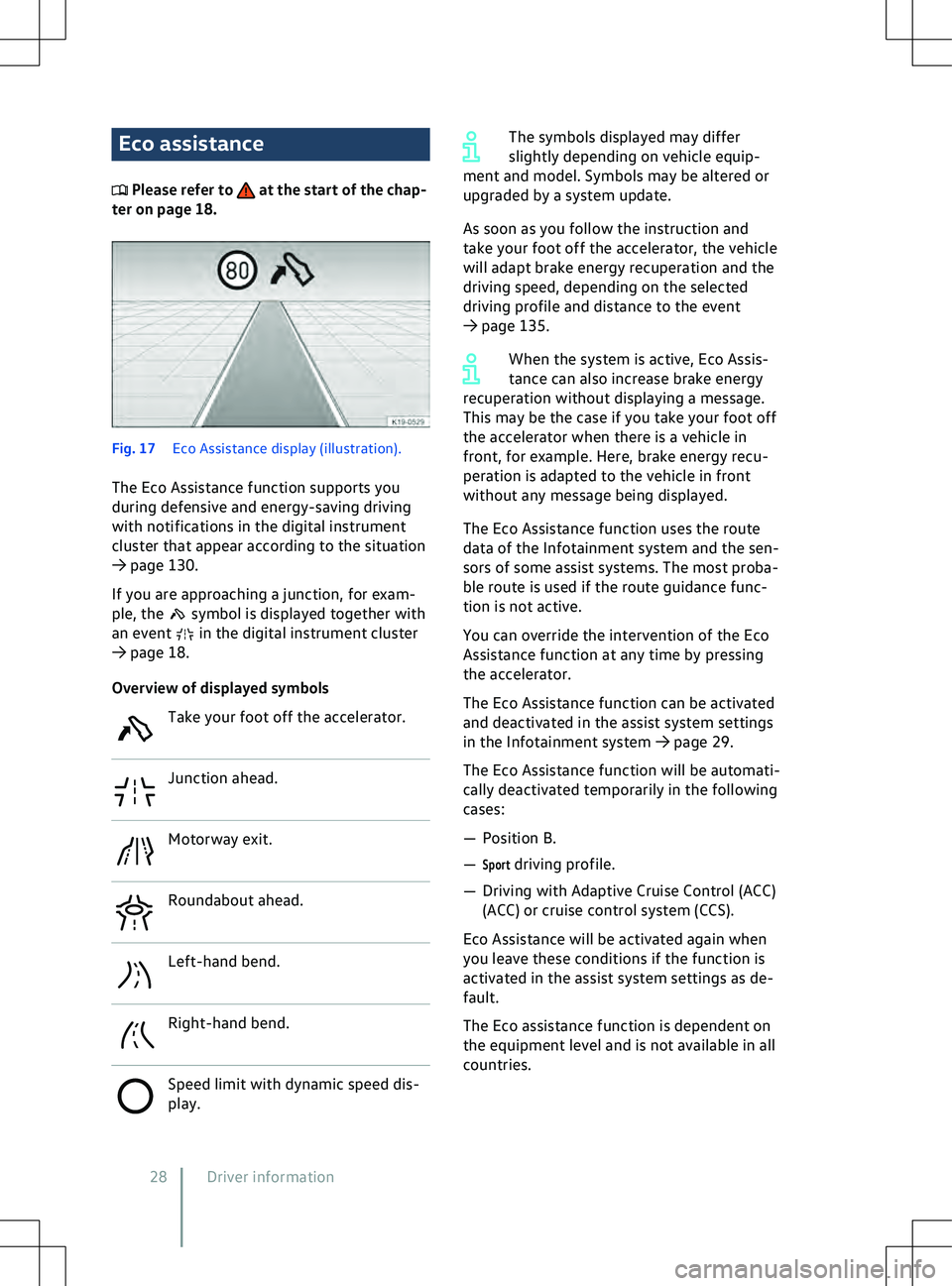
Eco assistance
Please refer to at the start of the chap-
ter on page 18. Fig. 17
Eco Assistance display (illustration).
The Eco Assistance function supports you
during def
ensive and energy-saving driving
with notifications in the digital instrument
cluster that appear according to the situation
Page 32 of 417
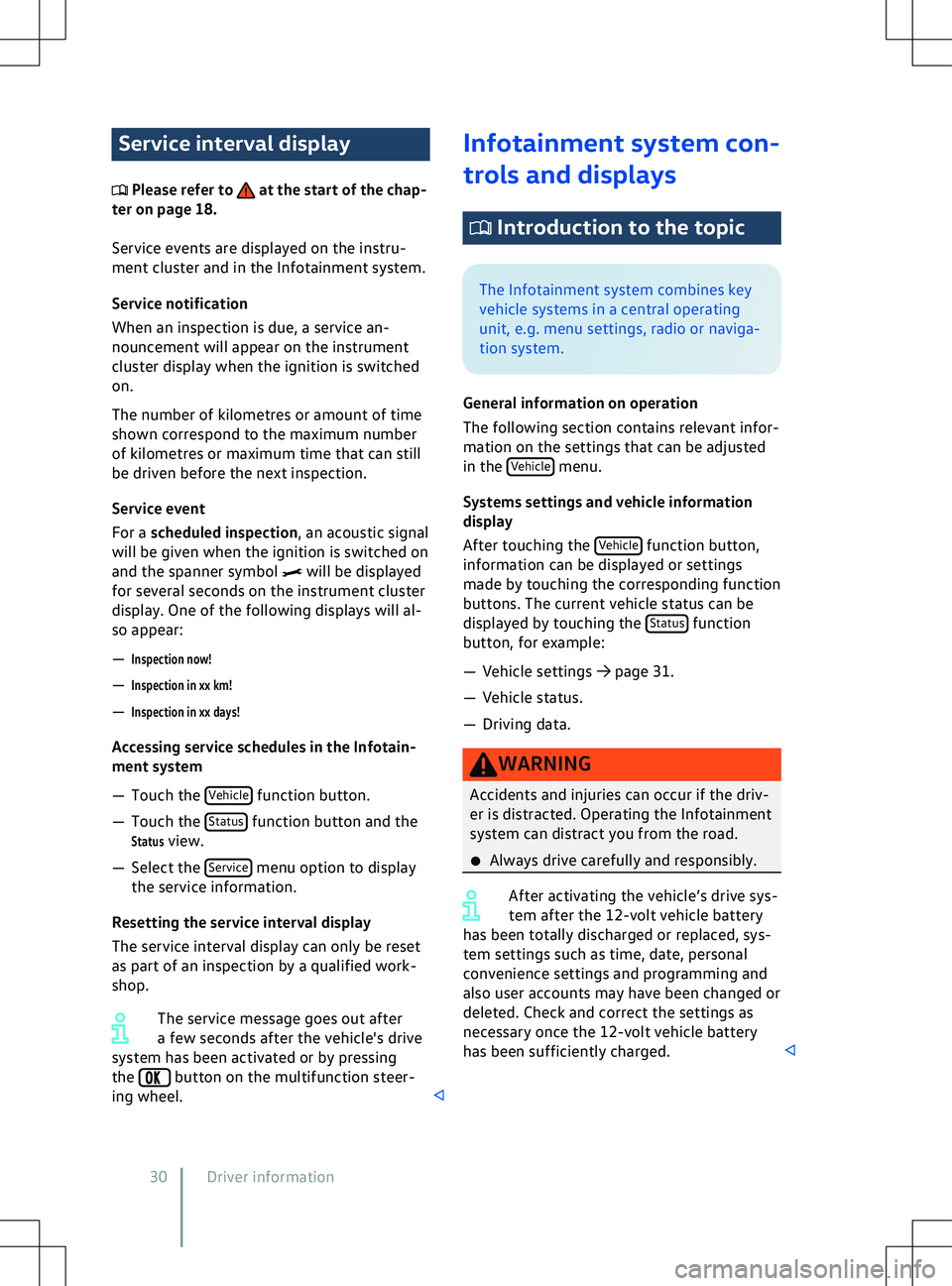
Service interval display
Please refer to at the start of the chap-
ter on page 18.
Service e
vents are displayed on the instru-
ment cluster and in the Infotainment system.
Service notification
When an inspection is due, a service an-
nouncement will appear on the instrument
cluster display when the ignition is switched
on.
The number of kilometres or amount of time
shown correspond to the maximum number
of kilometres or maximum time that can still
be driven before the next inspection.
Service event
For a scheduled inspection, an acoustic signal
will be given when the ignition is switched on
and the spanner symbol will be displayed
f
or several seconds on the instrument cluster
display. One of the following displays will al-
so appear:
Page 40 of 417
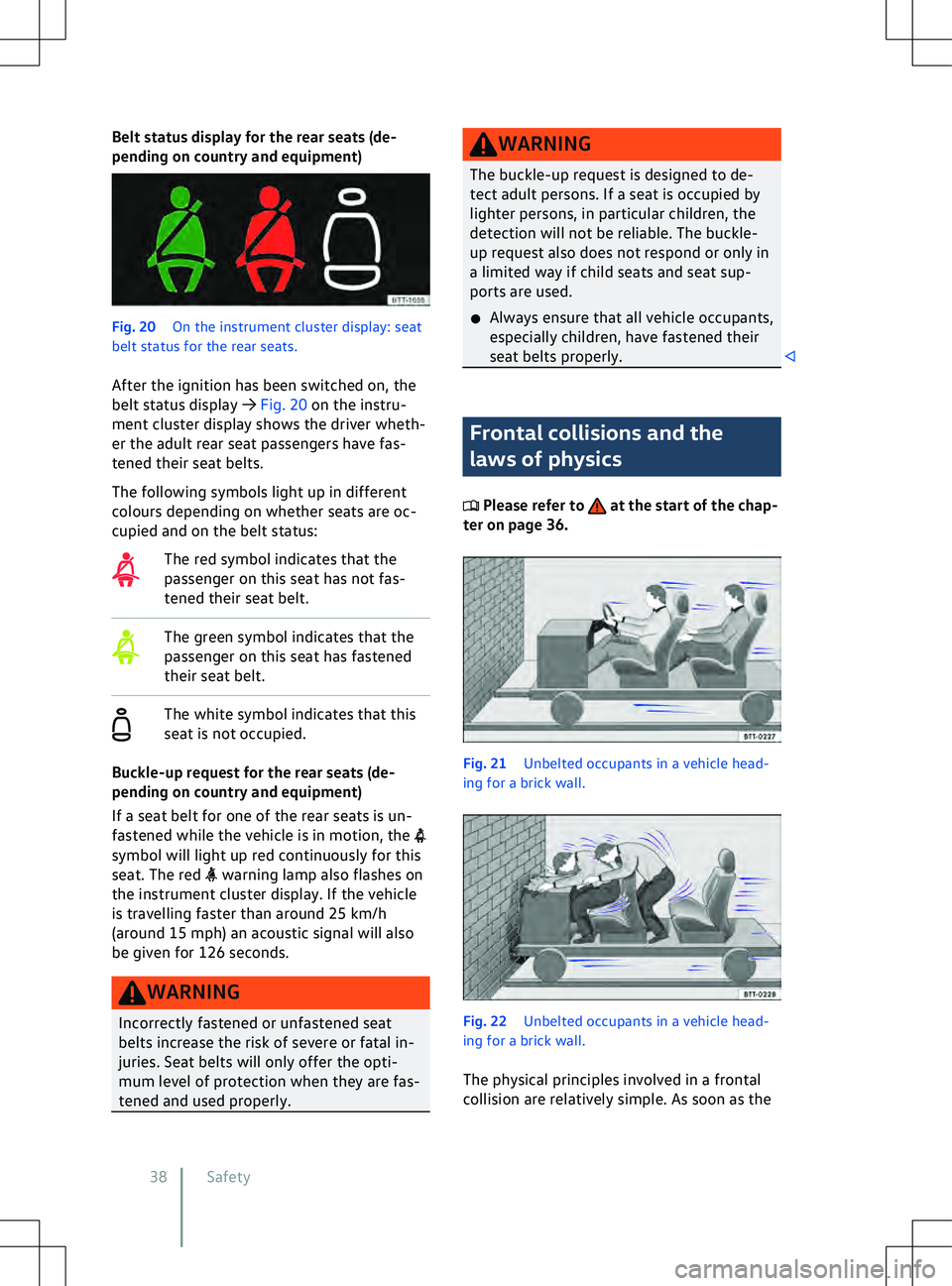
Belt status display for the rear seats (de-
pending on country and equipment)
Fig. 20
On the instrument cluster display: seat
belt status f or the rear seats.
After the ignition has been switched on, the
belt status display
Page 48 of 417
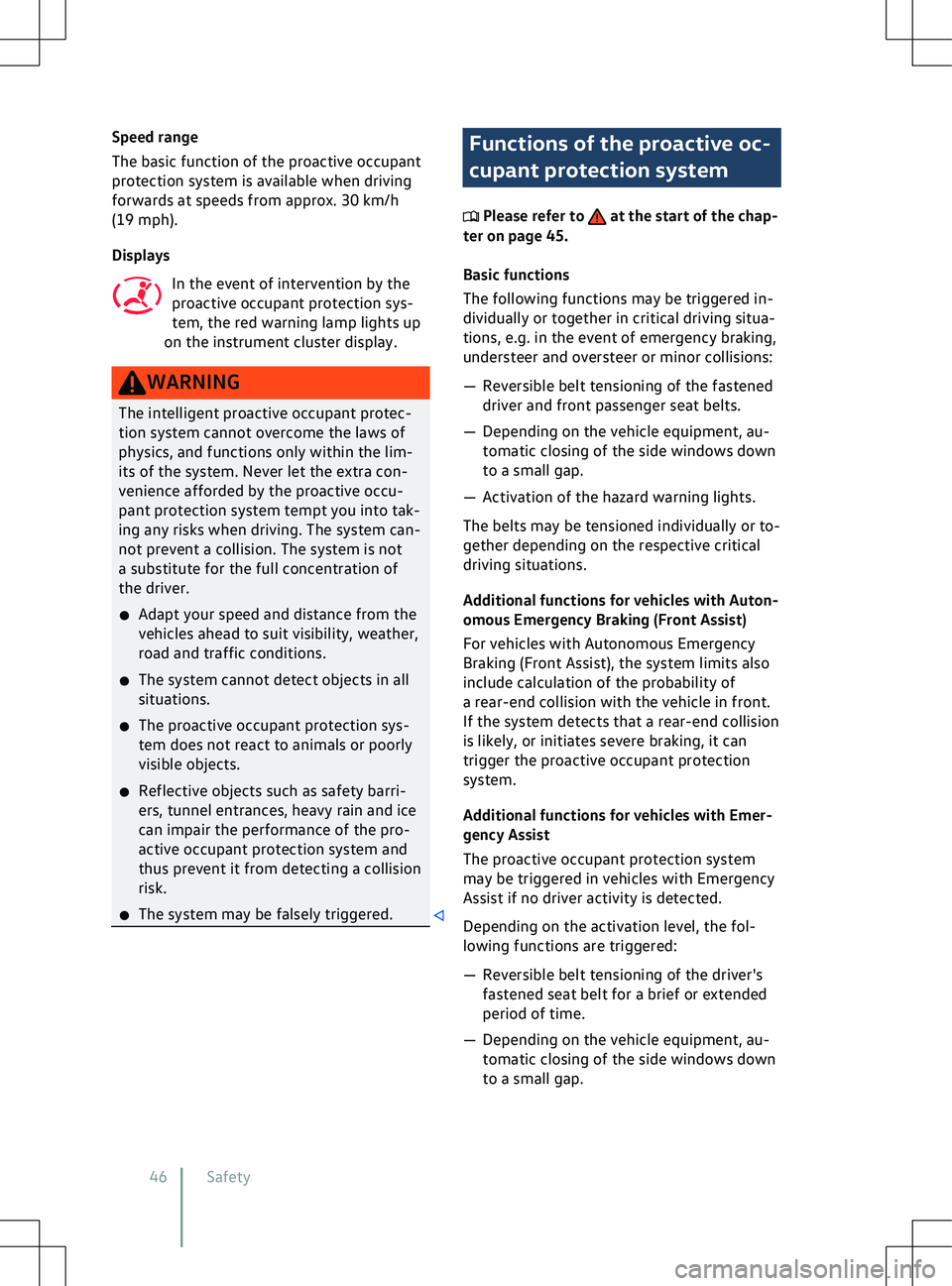
Speed range
The basic function of the proactiv
e occupant
protection system is available when driving
forwards at speeds from approx. 30 km/h
(19 mph).
Displays
In the event of intervention by the
proactive occupant protection sys-
tem, the red warning lamp lights up
on the instrument cluster display. WARNING
The intelligent proactive occupant protec-
tion system cannot o
vercome the laws of
physics, and functions only within the lim-
its of the system. Never let the extra con-
venience afforded by the proactive occu-
pant protection system tempt you into tak-
ing any risks when driving. The system can-
not prevent a collision. The system is not
a substitute for the full concentration of
the driver.
�x Adapt your speed and distance from the
vehicles ahead to suit visibility, weather,
road and traffic conditions.
�x The system cannot detect objects in all
situations.
�x The proactive occupant protection sys-
tem does not react to animals or poorly
visible objects.
�x Reflective objects such as safety barri-
ers, tunnel entrances, heavy rain and ice
can impair the performance of the pro-
active occupant protection system and
thus prevent it from detecting a collision
risk.
�x The system may be falsely triggered. Functions of the proactive oc-
cupant protection system
Please refer to at the start of the chap-
ter on page 45.
Basic functions
The f
ollowing functions may be triggered in-
dividually or together in critical driving situa-
tions, e.g. in the event of emergency braking,
understeer and oversteer or minor collisions:
Page 52 of 417
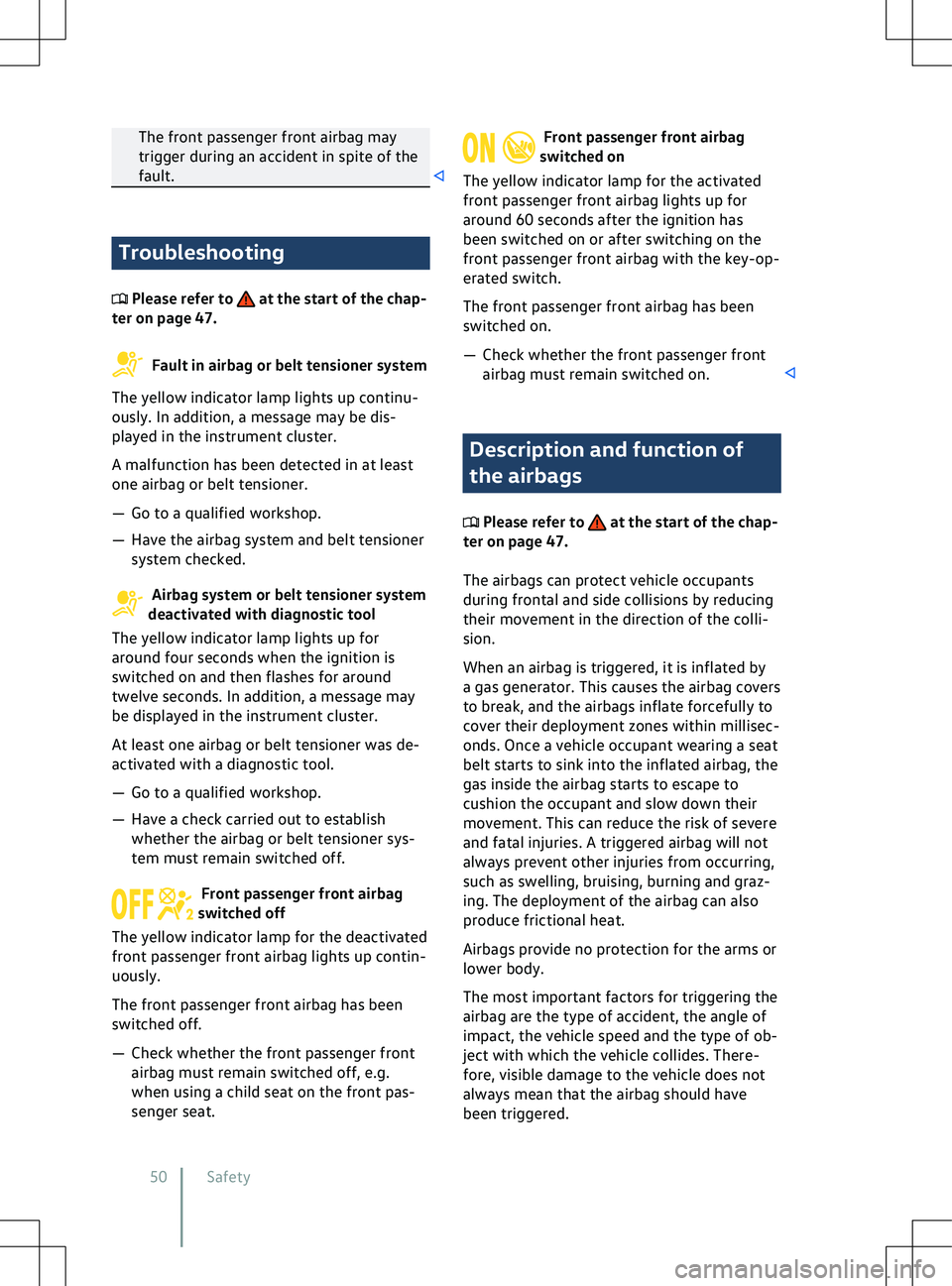
The front passenger front airbag may
trigger during an accident in spite of the
fault.
Troubleshooting
Please refer to at the start of the chap-
ter on page 47. Fault in airbag or belt tensioner system
The yellow indicator lamp lights up continu-
ously. In addition, a message may be dis-
played in the instrument cluster.
A malfunction has been detected in at least
one airbag or belt tensioner.
Page 153 of 417
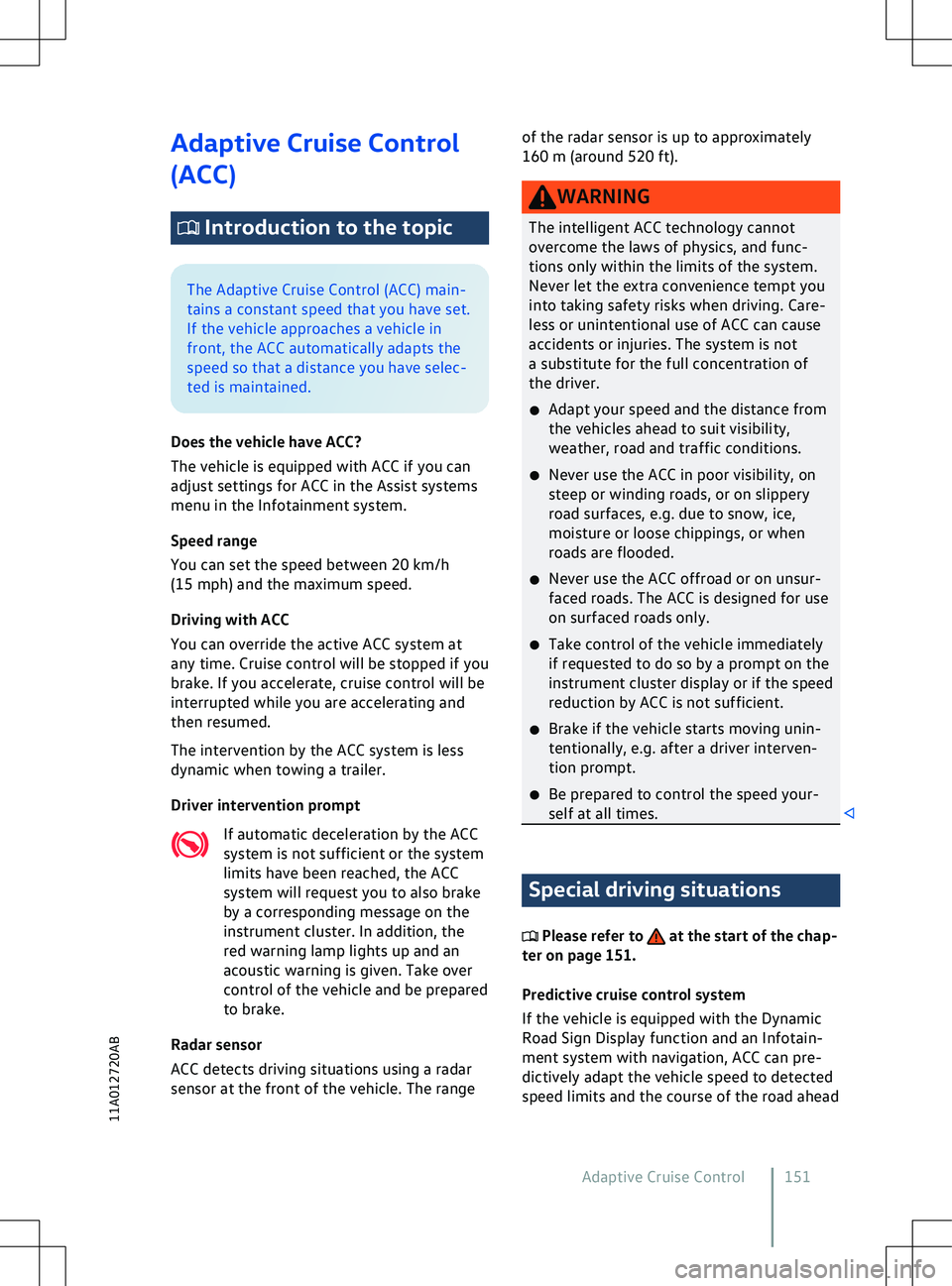
Adaptive Cruise Control
(ACC)
Introduction to the topic
The Adaptive Cruise Control (ACC) main-
tains a constant speed that you ha
ve set.
If the vehicle approaches a vehicle in
front, the ACC automatically adapts the
speed so that a distance you have selec-
ted is maintained.
Does the vehicle have ACC?
The vehicle is equipped with ACC if you can
adjust settings for ACC in the Assist systems
menu in the Infotainment system.
Speed range
You can set the speed between 20 km/h
(15 mph) and the maximum speed.
Driving with ACC
You can override the active ACC system at
any time. Cruise control will be stopped if you
brake. If you accelerate, cruise control will be
interrupted while you are accelerating and
then resumed.
The intervention by the ACC system is less
dynamic when towing a trailer.
Driver intervention prompt
If automatic deceleration by the ACC
system is not sufficient or the system
limits have been reached, the ACC
system will request you to also brake
by a corresponding message on the
instrument cluster. In addition, the
red warning lamp lights up and an
acoustic warning is given. Take over
control of the vehicle and be prepared
to brake.
Radar sensor
ACC detects driving situations using a radar
sensor at the front of the vehicle. The range of the radar sensor is up to approximately
160 m (
around 520 ft). WARNING
The intelligent ACC technology cannot
o
vercome the laws of physics, and func-
tions only within the limits of the system.
Never let the extra convenience tempt you
into taking safety risks when driving. Care-
less or unintentional use of ACC can cause
accidents or injuries. The system is not
a substitute for the full concentration of
the driver.
�x Adapt your speed and the distance from
the vehicles ahead to suit visibility,
weather, road and traffic conditions.
�x Never use the ACC in poor visibility, on
steep or winding roads, or on slippery
road surfaces, e.g. due to snow, ice,
moisture or loose chippings, or when
roads are flooded.
�x Never use the ACC offroad or on unsur-
faced roads. The ACC is designed for use
on surfaced roads only.
�x Take control of the vehicle immediately
if requested to do so by a prompt on the
instrument cluster display or if the speed
reduction by ACC is not sufficient.
�x Brake if the vehicle starts moving unin-
tentionally, e.g. after a driver interven-
tion prompt.
�x Be prepared to control the speed your-
self at all times. Special driving situations
Please refer to at the start of the chap-
ter on page 151.
Predictiv
e cruise control system
If the vehicle is equipped with the Dynamic
Road Sign Display function and an Infotain-
ment system with navigation, ACC can pre-
dictively adapt the vehicle speed to detected
speed limits and the course of the road ahead
Adaptive Cruise Control 151
11A012720AB